No products in the cart.
Newsletter
Cultivariable Newsletter Oct. 2020
Cultivariable October 2020 Newsletter
As usual, I have done a poor job with the newsletter this year and I will now try to cram in a few before the end of the year. 2020 has certainly been a strange year for the business, along with all of the other strangeness going on in the world. Sales have been brisk right through the summer, a time when I typically receive less than ten orders in a month. That has depleted a lot of seed stocks that I expected to last through several years and I will need to do some extra plantings to catch up next year. Of course, I am also concerned that, as things eventually return to normal, people may find that they have socked away more than they need, leading to a slump in 2021. Whatever happens, it won’t be boring!
This newsletter will have a new format. I previously outsourced our mailing list and newsletter, but the service that I was using became too expensive. I am now using self-hosted Mailtrain, which has a bit of a learning curve that I only started to climb last week, so this could be a mess. I am going to start posting the newsletters on the website as well, so if you get something that turns out to be formatted strangely, please bear with me while I work out the kinks and look up the newsletter on the blog page.
If for no other reason, 2020 has been a great year because I have finally passed through several years of expensive and time-consuming disease testing and management to ensure that our varieties are free of viruses and other pathogens. That left me without a profit for the past few years, which was difficult, so the increased orders this year have been very much appreciated, even if it turns out to be a temporary phenomenon. The good news is that I will have a lot of oca, ulluco, and mashua varieties back in stock this year. Harvest of most Andean tubers will take place sometime between the last week of November and middle of December, which means that the tubers will most likely be entered into stock by early January. Most potatoes have already been harvested and I have a greater selection of both potato tubers and TPS available than ever before. I will highlight some of the new varieties below.
Although I promised it, the podcast did not happen this year and that is largely due to the surprise increase in orders. There just wasn’t time to make it happen. It is possible that I will manage to do one before the end of the year, but more likely that I won’t. I will do my best to bring it back next year. There are many interesting people who I would like to talk to and it is just a matter of finding the time.
I’m shipping out as many orders as possible before freezing weather arrives. That will mostly be potato orders, since most of you who are inland will have cold weather before I even harvest the Andean tubers. Expect to see those orders in the spring. This is also a good time to remind you that I am now shipping yacon only in the spring. It just makes everything easier on my end and relieves you of the burden of storing it through the winter.
After a hiatus of several years, I have begun shipping seeds internationally again. You can read more about that here: A Change to Our International Shipping Policy (Again)
Thanks for sticking with me through the ups and downs. Every year has been different, but the overall trend is positive and, although I had some doubts the past couple of years, I think that Cultivariable will be around for the long run. That is only possible because of your support. I hope that you are all weathering these strange times without too much difficulty.
Sincerely,
William Whitson
New Products
It is currently potato season. I know that many of you are looking forward to new ocas, ullucos, mashuas, and yacons, and they are coming, but you’ll have to hold on another month or two to hear about those.
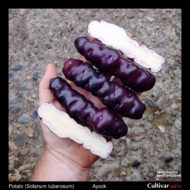 |
Ayock PotatoAyock is a spectacular looking purple fingerling, selected from high dormancy diploid potatoes. It is not a top yielder, but it produces reliably by mid-season, and has excellent dormancy, so it would be a good potato to try if you are looking to experiment with diploid potatoes as it doesn’t require extreme measures to grow or store. Both tubers and TPS are available. |
Bloody Banana PotatoBloody Banana is a pretty spectacular diploid potato with red and yellow skin and intense yellow flesh with a bit of red. It is a starchy potato with a rich flavor and I’m pretty happy with it. It has reasonable dormancy, but not as much as most tetraploids, so it is probably suited better to coastal climates than inland. Tubers will be available next year, but TPS is available now. Thanks to customer Wes Tucker for the name! |
|
Gunter Blue PotatoGunter Blue was a new selection last year, which goes back on the material side to the Pacific Northwest heirloom variety Johnny Gunter. Like its parent, it performed very well through the typical summer drought that we experience in this region and produced heavy yields. Unlike its parent, it is a beautiful blue with marbled blue flesh. This is a great baker. Both tubers and TPS are available. |
|
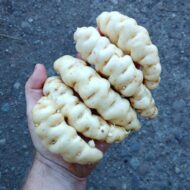 |
Jancko Ajawiri Potato (Solanum ajanhuri)Jancko Ajawiri is an example of Solanum ajanhuiri, a species grown only at the highest elevations in Peru and Bolivia, where it is prized for a higher level of frost resistance than is found in Solanum tuberosum. I have offered it for several years, but I have something new and special this year: true seed! It is hard to get this hybrid species to set seed, but I hand pollinated with diverse pollen from domesticated diploids and managed to get enough to offer. If you want to grow something unique that few people have ever had the opportunity to grow before, this is it. |
Loowit PotatoLoowit has been a frustrating variety. It is not new, but I have barely had the chance to offer it since I selected it, first due to a virus that had to be removed and then this year due to voles. So, no tubers, but I did finally manage to collect enough TPS to offer and I know from experience that about a quarter of the plants from TPS will have red flesh or red and yellow flesh. You can get some really beautiful potatoes from this seed. |
|
Nebula PotatoNebula was selected last year based on a single criterion: it was the best example I have seen of a potato that combines both red and blue in the skin color. It also has a wonderful, nutty aroma and flavor. The yield was not quite high enough for it to be a long term keeper, so this is the only year that I will offer tubers, but I think more people will be interested in the TPS, so that they can attempt to improve upon Nebula’s looks with a higher performing plant. |
|
Ozette PotatoOzette is certainly not new, but I have never offered it before. This excellent Pacific Northwest heirloom variety is probably the oldest extant variety in the United States. It was common in catalogs for a while, but really dropped off and, in recent years, it has only been possible to find tubers that were infected with viruses. These are virus free (as always, within the limits of my testing) and I have decided to keep them in the catalog for a while. Not a huge crop this year, so I imagine they will sell out early, but I will have quite a bit more in 2021. |
|
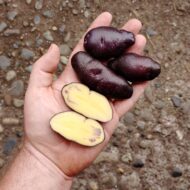 |
Valparaiso Potato (Solanum maglia x S. tuberosum)Valparaiso is a new curiosity, the best of my crosses between the Chilean wild potato Solanum maglia and diploid domesticated potatoes. The tubers were just a little bitter and I don’t yet know if that is intrinsic or if they got a little too much sun while I was drying them. Regardless, this is a potato that most people would be more likely to breed with than to eat, due to the small size. The plants have a lot of interesting traits and cross easily with other diploid potatoes. Using Valparaiso as a parent may help you to produce diploids with larger plant size, better dormancy, and day neutral tuberization. Both tubers and TPS are available. You can read more about using Solanum maglia in breeding here: Crossing Between Solanum maglia and Domesticated Diploids |
Other new offerings in potatoes include TPS of Blue Bolivian and Chiar Choque Pitu, two varieties of the frost-resistant species Solanum curtilobum; Chiquilla Pitiquiña, a Peruvian diploid with an unusual pine cone shape; Jancko Phiñu, a Bolivian diploid with superior disease resistance; Kinigi, a tetraploid variety with superior disease resistance; Llumchuy Waqachi, one of those classically lumpy Peruvian potatoes that you would expect to see in National Geographic; Lumper, the (in)famous Irish heirloom (which is selling out fast); SA-450, a tetraploid Peruvian variety with very long vines; and Yungay, a very yellow and very popular modern tetraploid variety from South America.
There are also some new offerings in wild potatoes this year, including diploid Solanum acroscopicum, tubers from a wider selection of Solanum jamesii accessions, and tubers of the natural hybrid species Solanum x sambucinum from Mexico. There will be other new wild potato offerings this year, but harvest is still probably about a month out for those.
Some fresh oca true seed is in stock, including the Group 3 mix and individual varieties Pascou, Siwash, and Wishkah. More will be coming soon, as I am processing oca seed now. I was able to drop prices a little on some of the individual varieties due to better than usual crops.
Plans for 2021
Next year, I will continue with the evaluation of Andean potato genebank accessions, the ongoing results of which you can see here: Evaluation of USDA Andean Potato Accessions
The best material from those evaluations goes into my true potato seed mixes.
I will also have two other major projects next year:
Oca Seedling Selection
I had high hopes for some of the oca seedlings selected in my last big grow out in 2019, but sadly, they all turned out to be disappointments. Don’t get me wrong, some are very nice varieties that I will probably offer, but none of them broke the 13 hour tuberization barrier that stands in the way of wider growing of oca outside maritime climates. So, I am gearing up to grow another 5000 seedlings from my earliest lines next year. This is the plant breeding grind; sooner or later, I am bound to get lucky.
Solanum jamesii Selection
The little Four Corners Potato seems to have really captured the imagination of many people and I get a lot of requests for it. The tubers are just so small that it is hard to think of it as a practical edible. I have had some luck selecting for larger sizes and next year I will grow about 50 different lines, looking for better parent material and making crosses with my best results. I’m hoping to work up to an average tuber size of at least 1.5 inches, which would make them much easier to harvest and cook.
If you made it to here, thanks for taking the time to read to the end! If I am really on top of my game, you’ll get another newsletter around Thanksgiving. If not, probably close to the end of the year.

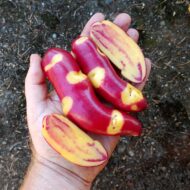
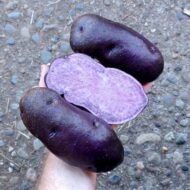
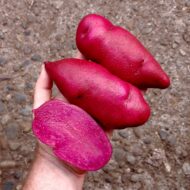
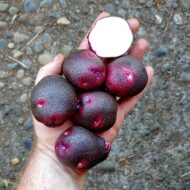
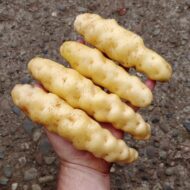
Interesting read, and great new products! And wow, 5k oca seedlings. Yes, you’re bound to get lucky at some point. Are you planning to pull them up all in the end of September 2021 and see? What if not even a single one tuberizes? Will you grow another 20k+ then?
I will pull them the last week of September. It is always a somewhat depressing process, but it is the only sure way to find the early ones. Odds are very good that some will have formed tubers, as this has been the case in the past with smaller numbers of plants, but they may still not be early enough to represent a breakthrough. I can’t really do more than 5K, as I also have to grow things that actually make money. ;)
A question: are you planning to offer Redshift seeds this year?
I haven’t processed them yet, but I expect that I will have enough to offer.
Redshift is now in stock.
Friends, good day, do you ship to Wa state or B.C. ,Canada?
Thank you,
Dennis
I’m in WA, so I definitely ship there. Seeds only to BC, with no guarantee of arrival for international orders. So, if you can receive orders in WA, that’s a safer bet.
Can you explain dormancy? I live in lower Appalachians of GA, zone 7b/8a. I like the colored potatoes best. I’m not going to buy the potato tower after reading your article, but going for hills, cinder blocks or containers. Seems like rodents may become a problem with tubers? I have 10 potato seed mixes in my cart, and want to choose the best six. When it says high dormancy or low dormancy, how does this impact the varieties I should choose?
Dormancy is the period of time between when the plant dies back and when the tubers begin sprouting. In most of North America, you want potatoes with high dormancy because we have winters with temperatures below freezing, when you can’t grow potatoes. Low (or no) dormancy potatoes begin sprouting again pretty quickly after harvest – anywhere from immediately to a few weeks. That allows them to be planted again right away, so you can have multiple crops per year. But that only works well if you live in a frost-free climate or have a pretty short winter. You can keep them alive through winter in a refrigerator, but that is kind of a hassle unless you really want to grow them.